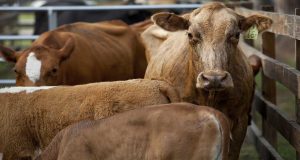As a cow ambles around and eats from the feed bunk, legions of other “animals” are feeding within the cow’s rumen. Billions of protozoa swim about in a single, 20-gallon rumen, colliding with one another while engulfing feed particles and bacteria. These microbes contribute vitally to rumen fermentation and have both positive and negative impacts on animal performance. This 4-page fact sheet discusses classification, activities, removal, and impacts of protozoa. Written by Timothy J. Hackmann, and published by the UF Department of Animal Sciences, January 2017.
http://edis.ifas.ufl.edu/an331
Tag: Dairy Health Management
Comparing Waterbeds and Sand Beds for Cows: A Study at the UF/IFAS Dairy Unit (VM194)
 One important aspect of a cow’s comfort is the type of bedding used. Waterbeds for cows have recently gained popularity because of advertisements, news reports in outlets such as CNN. The UF/IFAS Dairy Unit (DU) provides a good opportunity to compare sand beds and waterbeds at optimal conditions. The dairy has waterbeds installed in one half of the barns and sand beds in the other half. This publication provides a field comparison of waterbeds and sand beds in one herd. We observed that when stalls are maintained at optimal conditions, cows in sand-bedded stalls had decreased incidence of hock lesions and increased stall usage compared to cows in waterbeds. This 5-page fact sheet was written by Klibs N. Galvão and Ori Eizenberg, and published by the UF Department of Veterinary Medicine-Large Animal Clinical Sciences, May 2013.
One important aspect of a cow’s comfort is the type of bedding used. Waterbeds for cows have recently gained popularity because of advertisements, news reports in outlets such as CNN. The UF/IFAS Dairy Unit (DU) provides a good opportunity to compare sand beds and waterbeds at optimal conditions. The dairy has waterbeds installed in one half of the barns and sand beds in the other half. This publication provides a field comparison of waterbeds and sand beds in one herd. We observed that when stalls are maintained at optimal conditions, cows in sand-bedded stalls had decreased incidence of hock lesions and increased stall usage compared to cows in waterbeds. This 5-page fact sheet was written by Klibs N. Galvão and Ori Eizenberg, and published by the UF Department of Veterinary Medicine-Large Animal Clinical Sciences, May 2013.
http://edis.ifas.ufl.edu/vm194
Improving Dairy Cow Metabolism through Safflower Oil Supplementation (AN271)
 Data collected in Florida studies indicate that feeding fat supplements that decrease milk fat test during the early postpartum period may help minimize negative energy balance, reduce body fat mobilization, and improve blood levels of beneficial metabolic and reproductive hormones. This 3-page fact sheet was written by Lokenga Badinga, Richard D. Miles, and Cristina Caldari-Torres, and published by the UF Department of Animal Science, September 2011.
Data collected in Florida studies indicate that feeding fat supplements that decrease milk fat test during the early postpartum period may help minimize negative energy balance, reduce body fat mobilization, and improve blood levels of beneficial metabolic and reproductive hormones. This 3-page fact sheet was written by Lokenga Badinga, Richard D. Miles, and Cristina Caldari-Torres, and published by the UF Department of Animal Science, September 2011.
http://edis.ifas.ufl.edu/an271
Omega-3 Fatty Acids Control Immune Stress in Dairy Cattle (AN264)

Understanding how omega-3 PUFA affect the immune functions of dairy cattle may lead to the development of producer-friendly feeding strategies that will decrease the incidence of diseases and improve reproductive efficiency in dairy cows. This 2-page fact sheet was written by Lokenga Badinga and Cristina Caldari-Torres, and published by the UF Department of Animal Science, July 2011.
http://edis.ifas.ufl.edu/an264
Understanding and Troubleshooting Milk Fat Depression in Dairy Herds (AN261)
 Sometimes energy-rich diets formulated to maximize milk production exert negative effects on milk fat. This 4-page fact sheet reviews some of the dietary factors that induce milk fat depression and explains how to troubleshoot this problem. Written by Leandro F. Greco and José E.P. Santos, and published by the UF Department of Animal Science, June 2011. (AP photo/University of Florida/IFAS/Josh Wickham)
Sometimes energy-rich diets formulated to maximize milk production exert negative effects on milk fat. This 4-page fact sheet reviews some of the dietary factors that induce milk fat depression and explains how to troubleshoot this problem. Written by Leandro F. Greco and José E.P. Santos, and published by the UF Department of Animal Science, June 2011. (AP photo/University of Florida/IFAS/Josh Wickham)
http://edis.ifas.ufl.edu/an261
Identifying and Treating Uterine Disease in Dairy Cows (VM179)
Uterine diseases are prevalent in high producing dairy cows and require prompt diagnosis and treatment. This 6-page fact sheet describes identification and treatment for four classes of uterine diseases in dairy cows. Written by Klibs N. Galvão, Carlos Risco, and Jose E.P. Santos, and published by the UF Department of Veterinary Medicine, May 2011.
http://edis.ifas.ufl.edu/vm179
ENY251/IG050 External Parasites of Dairy Cattle
Revised! ENY-251, a 23-page fact sheet by P. E. Kaufman, P. G. Koehler and J. F. Butler, describes the biology and management of the most important external parasites of dairy cattle in Florida. Includes references and tables of pesticide information. Published by the UF Department of Entomology and Nematology, May 2009.
http://edis.ifas.ufl.edu/IG050
AN205/AN205 Troubleshooting a Herd with a High Bacteria Count
AN205, a 2-page fact sheet by David R. Bray, lists some common problems in dairy procedures which can cause a high bacteria count in a dairy herd. Published by the UF Department of Animal Sciences, June 2008.
http://edis.ifas.ufl.edu/AN205
